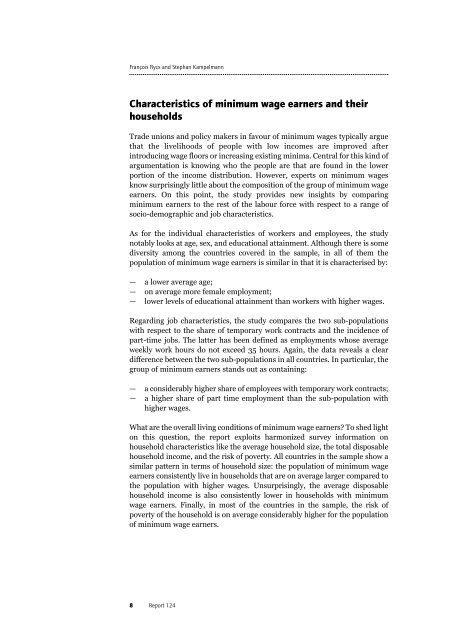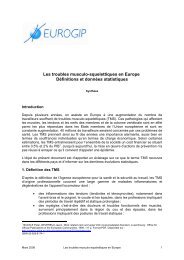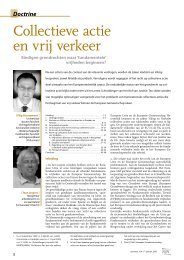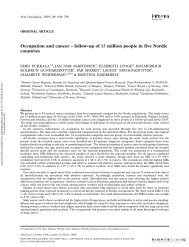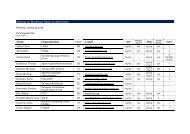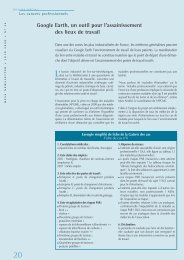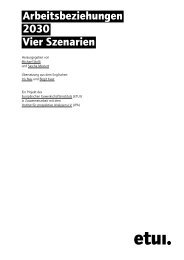Who earns minimum wages in Europe - European Trade Union ...
Who earns minimum wages in Europe - European Trade Union ...
Who earns minimum wages in Europe - European Trade Union ...
You also want an ePaper? Increase the reach of your titles
YUMPU automatically turns print PDFs into web optimized ePapers that Google loves.
François Rycx and Stephan Kampelmann<br />
Characteristics of <strong>m<strong>in</strong>imum</strong> wage earners and their<br />
households<br />
<strong>Trade</strong> unions and policy makers <strong>in</strong> favour of <strong>m<strong>in</strong>imum</strong> <strong>wages</strong> typically argue<br />
that the livelihoods of people with low <strong>in</strong>comes are improved after<br />
<strong>in</strong>troduc<strong>in</strong>g wage floors or <strong>in</strong>creas<strong>in</strong>g exist<strong>in</strong>g m<strong>in</strong>ima. Central for this k<strong>in</strong>d of<br />
argumentation is know<strong>in</strong>g who the people are that are found <strong>in</strong> the lower<br />
portion of the <strong>in</strong>come distribution. However, experts on <strong>m<strong>in</strong>imum</strong> <strong>wages</strong><br />
know surpris<strong>in</strong>gly little about the composition of the group of <strong>m<strong>in</strong>imum</strong> wage<br />
earners. On this po<strong>in</strong>t, the study provides new <strong>in</strong>sights by compar<strong>in</strong>g<br />
<strong>m<strong>in</strong>imum</strong> earners to the rest of the labour force with respect to a range of<br />
socio-demographic and job characteristics.<br />
As for the <strong>in</strong>dividual characteristics of workers and employees, the study<br />
notably looks at age, sex, and educational atta<strong>in</strong>ment. Although there is some<br />
diversity among the countries covered <strong>in</strong> the sample, <strong>in</strong> all of them the<br />
population of <strong>m<strong>in</strong>imum</strong> wage earners is similar <strong>in</strong> that it is characterised by:<br />
— a lower average age;<br />
— on average more female employment;<br />
— lower levels of educational atta<strong>in</strong>ment than workers with higher <strong>wages</strong>.<br />
Regard<strong>in</strong>g job characteristics, the study compares the two sub-populations<br />
with respect to the share of temporary work contracts and the <strong>in</strong>cidence of<br />
part-time jobs. The latter has been def<strong>in</strong>ed as employments whose average<br />
weekly work hours do not exceed 35 hours. Aga<strong>in</strong>, the data reveals a clear<br />
difference between the two sub-populations <strong>in</strong> all countries. In particular, the<br />
group of <strong>m<strong>in</strong>imum</strong> earners stands out as conta<strong>in</strong><strong>in</strong>g:<br />
— a considerably higher share of employees with temporary work contracts;<br />
— a higher share of part time employment than the sub-population with<br />
higher <strong>wages</strong>.<br />
What are the overall liv<strong>in</strong>g conditions of <strong>m<strong>in</strong>imum</strong> wage earners? To shed light<br />
on this question, the report exploits harmonized survey <strong>in</strong>formation on<br />
household characteristics like the average household size, the total disposable<br />
household <strong>in</strong>come, and the risk of poverty. All countries <strong>in</strong> the sample show a<br />
similar pattern <strong>in</strong> terms of household size: the population of <strong>m<strong>in</strong>imum</strong> wage<br />
earners consistently live <strong>in</strong> households that are on average larger compared to<br />
the population with higher <strong>wages</strong>. Unsurpris<strong>in</strong>gly, the average disposable<br />
household <strong>in</strong>come is also consistently lower <strong>in</strong> households with <strong>m<strong>in</strong>imum</strong><br />
wage earners. F<strong>in</strong>ally, <strong>in</strong> most of the countries <strong>in</strong> the sample, the risk of<br />
poverty of the household is on average considerably higher for the population<br />
of <strong>m<strong>in</strong>imum</strong> wage earners.<br />
8 Report 124


